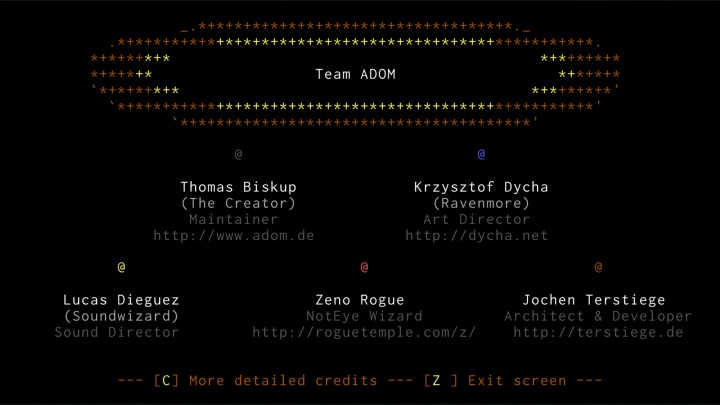ADOM (Ancient Domains of Mystery): How 15,000 Lines of Code Changed RPGs
A retrospective on a gaming classic that still has legs almost 30 years later.

Life hasn't been the most exciting lately. I love to travel, so naturally, the shutdown that brought 2020 to a halt has forced me to take up, well, less-preferred means of adventuring. One such method is to explore the open worlds of video games, some of which were created before I was born.
This is how, in an era of adventure-less ennui, I discovered Ancardia — a world created by computer programmer Thomas Biskup with only 15,000 lines of code in 1992. While of course I would rather be spleunking in the Cayman Islands than spelunking in digital caves, I am grateful that a mundane state of existence led me to ADOM, a game that has since replaced Fallout 2 as my official "desert island" video game.

Ancient Domains of Mystery (ADOM), an ASCII dungeon crawler, is a game that visually can't compare even to titles from its own era, like Fallout and Baldur's Gate. In my state of quarantined boredom, and in search of exercise for my spiraling and weakening mind, perhaps I'm attracted to the idea of a graphically underwhelming game. In ADOM, when the PC approaches a goblin deep within the Caverns of Chaos, the game depicts it simply as a letter "g." It's up to the player's imagination to do the rest. In this way, the world of Ancardia is as dark or colorful, as vague or detailed, as Hadean or alive as we want it to be.

While death is a frustratingly common occurrence in vintage games (rapidfire quicksaves are the only way to survive Fallout), in ADOM, as is the nature of roguelikes, death more accurately takes on the role of a boss fight than a misstep. Dying is just part of the experience, and fighting off death as long as possible is the true roguelike adventure.
Perhaps that in-game struggle to stay alive has struck a chord here in 2021, as every day becomes more of a roguelike itself, pitting tired wanderers against the visually nondescript foes of monotony and solitude.
Or, ostentatious metaphors and dark parallels aside, perhaps ADOM is simply a timeless masterpiece unrestrained by graphics cards and CPUs. It is a world that relies on imagination alone to take players into the wild. Whatever the reason behind my newfound investment in this game and its creator, I stand behind the following statement: RPGs and the roguelike genre are both better off today thanks to the groundwork laid by an unassuming German programmer in the mid-90s.
It's a bold statement, but I'm prepared to back it up as best I can. Let's start at the beginning.
The First Iteration ("Advanced Dungeons of Mystery")
Thomas Biskup would not consider himself a game designer, at least not by trade. True, one of his Twitter handles is simply @adom_dev. Yes, googling his name results in more "ADOM" search results than anything else. But other than spending his mid-20s creating the game that would become his legacy, Biskup hasn't contributed anything else of note to the gaming community (although he is working on a sequel to ADOM, currently available in early access on Steam). This is not meant as a criticism; again, I believe Biskup's contribution to the gaming ecosystem has already been profound, albeit understated. Simply put, Biskup considers himself a businessman first, a CEO in fact, who finds himself in the not-so-uncommon position of supporting a 29-year-old child out of his own pocket and on his own time.

ADOM was "born" in 1992, when Biskup was looking for a school project that would test and expand his knowledge of C programming. At first, he thought about building a game on the foundational code of Nethack, a successor to the OG roguelike Rogue, but instead, Biskup ended up making a rash, and life-changing, decision:
Modifying Nethack looks too complicated. I'll just make my own game — that's easier.
The result of the ensuing collaboration between Biskup and his trusted eMac (remember eMacs?) was, of course, the 15,000 lines of code that would constitute ADOM — an open world, turn-based dungeon crawler that tasks players with finding and eliminating the source of Chaos disrupting the universe. Before it was officially titled Ancient Domains of Mystery, ADOM was called Advanced Dungeons of Mystery and was a very different game from the final product, consisting of only one dungeon that contained 100 increasingly challenging levels. Finally, in 1996, Biskup released Ancient Domains of Mystery Version 0.7.0 — the first public release. Within months, the game was a proven success. It would go on to reach more free downloads in 1997 than any other game, including competitors like Age of Empires and Nethack 3.

Soon thereafter, Biskup says he received death threats from fans (fan-emies?) who said they wanted the game's source code and would do anything to get it. While measuring a project's success by the frequency and intensity of death threats is stilted, and at best an unfair metric, nonetheless Biskup knew he had created something special. Until 2001, the ADOM train appeared to be unstoppable, but then, life happened for Biskup, and his university passion project fell to the wayside.
"The Messy Middle"
I recently read a book by Scott Belsky called "The Messy Middle," where the now-SVP of Adobe talks about how the most difficult part of any venture is the unknown middle between ideation and completion. Regarding the trials of navigating this region, Belsky offers hundreds of quotable idioms to leaders and creators, such as "DYFJ" (Do Your F***ing Job), "Make a commitment to uncertainty," and "Curiosity is the fuel you need to play the long game," and, most notably:
Value the merits of slow cooking.
Between 2001 and 2010, Biskup spent almost no time maintaining and improving ADOM. Those years were invested in other projects: namely, falling in love, starting his company QuinScape, and attaining his PhD. Finding itself unattended to, but still boasting a cult following, ADOM slowly marinated in its unique stew of RPG and roguelike ingredients. Then, in 2010, Biskup overcame what can be viewed in hindsight as the "messy middle" of his venture, and, fueled by a slowly rekindled passion for the project, he set out on a quest of his own to revitalize the world of Ancardia.
The first step was raising funds, which he did via Indiegogo, a forebearer to crowdfunding platforms like Kickstarter. Backed by 1,666 supporters pledging more than $90,000 to the mission of resurrecting his RPG, Biskup ended up raising 183% of his initial goal of $48,000. Allegedly, Minecraft creator Markus Persson tried to donate $50,000 to the project, but was unable to do so because of a bug with the platform. This led to the menu splash message "I miss ADOM!" on the Alpha 1.0.0 release of Minecraft in 2010.

Even though they missed out on a $50,000 donation, Biskup successfully raised the funds and the morale he needed. ADOM was reborn.
Over the next decade, Biskup assembled a team, took the project to Steam and GOG, and ultimately added 216,000 more lines of code to modernize and solidify the game's experience. The ASCII interface was replaced by a fully realized tile wilderness, complete with characters that had bodies and color, as opposed to the unique keyboard identifiers that defined the original.

The Postcard Quest
As early as the game's first iteration, Biskup proved that he cared about the community he was building by coding a very specific call-to-action into the game's menu. By clicking on "The Postcard Quest," players are provided with Biskup's address and tasked with sending a postcard to "reward his efforts" in creating and maintaining ADOM.

Biskup says he has received hundreds of thousands of postcards from fans over the years, including one memorable one:
[It] must have been around 1996, [someone from] ex-Yugoslavia, and basically the message was "thank you for creating a game like ADOM that we can play on old computers. It helps us forget the war around us and all the suffering." ... There was something surreal and brilliant about how such games can affect people and their lives.
Thanks to this "Postcard Quest," which is accessible still to this day, Biskup continues to receive postcards from fans around the world.
Today, Biskup maintains ADOM as a love letter to a bygone era of gaming, as well as a reminder that strong storytelling isn't necessarily dependent on good visuals, or even any visuals. We shouldn't take that work, nor that influence, for granted. Whether that means sending a postcard, supporting him and his dev team on Steam, or writing an ADOM retrospective on Vocal, it's important to remember and acknowledge those who laid the foundation for games like The Binding of Isaac, Dwarf Fortress, and Hades. These games, as well as their developers, know who to thank for much of what the roguelike and RPG genres have become.
Thomas Biskup never expected his dungeon crawler to make a splash, but even at 29 years old, ADOM still packs a punch. [Literally ... My most recent character, Holden the dwarf priest, was punched to death by a golem.] With only 15,000 lines of code, Biskup wrote Ancient Domains of Mystery, and himself, into the gaming history books.

Let's make sure that history is not forgotten.
---
Joshua Luke Johnson is a senior content manager at Creatd and head of Content Moderation and Curation at Vocal.
About the Creator
Joshua Luke Johnson
Former Head of Content @ Vocal
Interview with Christopher Paolini: https://vocal.media/interview/christopher-paolini-interview-part-1-of-3







Comments
There are no comments for this story
Be the first to respond and start the conversation.